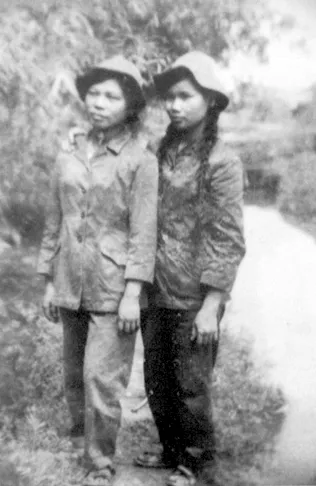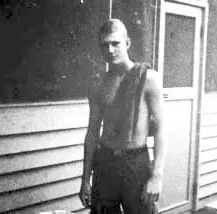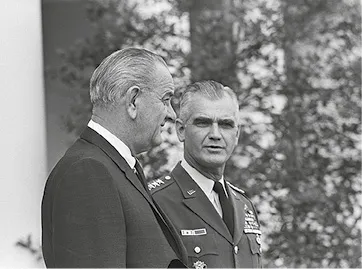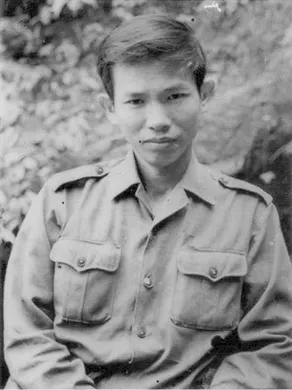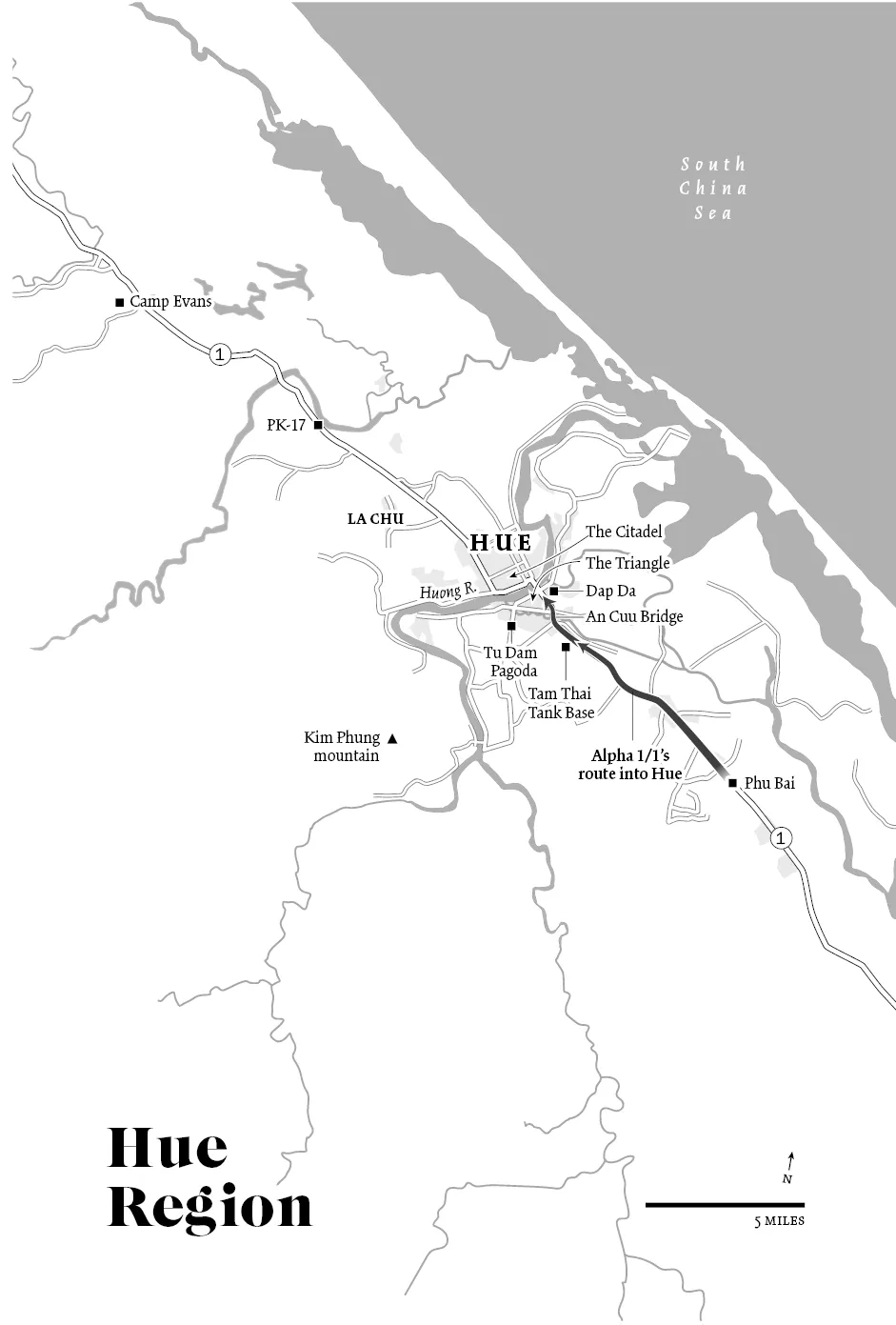![]()
PART ONE
The Infiltration
1967–January 30, 1968
Che Thi Mung (left) and Hoang Thi No,
village teenagers with the Huong River Squad
who fought American and ARVN forces.
Frank Doezema, the army radioman
who manned the guard tower at the MACV compound
when Front troops attacked.
President Johnson and General William Westmoreland
in the Rose Garden during the general’s November 1967 spizzerinctum tour.
Nguyen Dac Xuan, the Buddhist poet who became
a propagandist and commissar for the Front.
![]()
1
The Huong River Squad
IN THE AFTERNOON along Le Loi Street, uniformed children spill from school yards like flocks of freed birds, swinging backpacks, running or on bicycles, the boys in white shirts and shorts, the girls with their long black hair and the white flaps of their ao dai flying.
The street is Hue’s center. It runs along the south bank of the Huong River and is planted at intervals with plane trees that lean out over the busy flow of scooters and cars. On the street’s north side, along the riverbank, is a wide green promenade, and on the south side is a row of imposing stone buildings behind high walls painted in pastels of green, yellow, red, brown, and pink. Across the water rise the mottled, forbidding stone walls of the Citadel, a monumental fortress from another era. The river’s name, Huong, evokes the pleasing scent of incense or the pink and white petals that float downstream in autumn from orchards to the north. The Americans called it the Perfume River.
In 1968, there were more bicycles than scooters and cars beneath the trees on Le Loi Street. The image of a pretty girl on a bike in an ao dai, the traditional tunic with flaps in front and back, and a traditional conical hat—non la—was on the cover of the pocket guide GIs were issued on their way to the war in Vietnam.2
One of those cycling girls in January of that year was Che Thi Mung. She was eighteen and as pretty as the picture on the handbook. Che was a village girl with little schooling. Riding her bike in Hue, she was the picture of innocence: slender with a round face, big eyes, and high cheekbones. She worked with her family in the rice paddies and helped weave palm leaves from village trees into non la, which she sold on the city streets. She would stack the hats and strap them to the back of her bike.
But Che was neither as innocent nor as friendly as she looked. She knew nothing of the global clash of ideas that brought American soldiers to Vietnam, but the war was her life. Her position in it was dead certain. With all the passion of youth, she hated the Saigon regime, the Republic of Vietnam. This enmity was largely an inheritance. Before she was born, her father had fought with the Viet Minh against the French, and when she was a child he had been imprisoned for years by the Saigon regime, which had followed the French. In her mind they were the same, only now the shadow behind the local oppressor was not France, but the United States. Her father, a bricklayer, had been fighting his whole life. For Che, the war had turned even more personal two years earlier, when the ARVN killed her big sister, a leader in the VC underground. She knew the regime’s soldiers as nguy (fake), a word that in Vietnamese suggested a familiar Asian face masking an alien soul.3
After her sister was killed, the nguy had come looking for collaborators in Van The, her village, a small community of farmers and tradesmen in the Thuy Thanh district southeast of the city. It was off the main road and surrounded in all directions by well-tended rice fields, a flat and outwardly placid landscape. The weather was damp through most of the year but especially during the coastal region’s wet months from December through February, which were filled with cool days shrouded in gray mist. Far to the west were the stark green peaks of the Central Highlands; to the east, just a few miles distant, were beaches and the South China Sea. About three of four people in Van The shared Che’s feelings about the Saigon regime, so it was friendly ground for the VC. Her father was hidden by friends after Che’s sister was killed. They knew that once the nguy figured out who she was, they would unearth his record and come looking for him.
When they came, they found empty bunkers beneath Che’s house. Such shelters were common. Villagers dug them to hide from bombs or shells, and sometimes they were used to hide weapons or the VC. Sometimes village boys were sheltered there to avoid impressment by either side. So the ARVN could make what they wished of the bunkers.
In Che’s case, they were suspicious enough, weighed with the actions of her sister and the absence of her father, for her arrest. She was taken to an ARVN post in the city with her mother and paternal grandfather. Interrogators poured soapy water down her nose and throat until she choked and her ears rang and head and throat stung. They demanded she tell them where her father had gone and the names of the VC fighters from her village.
She cried and pleaded. She was just a girl! She told them she knew nothing. Why were they tormenting her? Did they think the VC confided in sixteen-year-old girls? Didn’t they have daughters? Sisters? For the rest of her life she would be proud of how tenaciously she protected her secrets. She told the nguy nothing.
She had joined the Viet Cong herself four years earlier, its Young Pioneer Organization.4 She was fiercely proud of her martyred sister, heartbroken over her death, fearful for her father, and determined to live up to their example. When she and her family were released, martial law was imposed on Van The. Most deeply resented was a curfew that confined the villagers to their homes after seven in the evening. But the nguy did not live in the village. They could not be there all the time, and they could not know which neighbors to trust. It was easy for fighters like Che to avoid the patrols and to attend nightly meetings and training sessions. As for the rest of the village, the crackdown just generated anger—and recruits.
Che would sometimes see Americans with the ARVN troops. They wore similar uniforms but the Americans were easy to spot even from a distance because they looked so different. For one thing, most were bigger. At night she and her family listened to stories on the radio of American bombing in North Vietnam, imagining the death, destruction, and misery, but she did not fear or hate the Americans so much as she did the nguy, who seemed to her much worse. They had sided with foreigners against their own people. They spoke her language and were Vietnamese in all respects except the most important.
For the two years after her arrest and interrogation, she lived a double life, a committed revolutionary at night, and a law-abiding citizen of South Vietnam during the day. She found work at the same ARVN post where she had been tortured, cleaning and doing odd jobs. She had been cleared and released, and so many were subjected to this treatment that even if suspicions about her lingered, she little feared being remembered. She would bicycle into the city, selling her hats and working at the post, and most evenings she would ride home and attend meetings where she and other village girls sharpened bamboo spikes for booby traps. She would stand watch and spread the alarm whenever the nguy or Americans approached.
The cadre she supported, her sister’s, took portions of the village harvest and carried it up to the hidden jungle camps in the highlands, what the troops referred to simply as xanh (the green). Mostly it was boys who did this work. The girls encouraged children to join the revolutionary youth groups, and tried to recruit villagers to the cause. Che would remind them of the onerous curfews, the rudeness of the soldiers who swept through periodically, and the arbitrary arrests and invented charges. She told them that the peace and freedom promised by the nguy and their American controllers was illusory. Their country was at war and would remain at war until the invaders and traitors were gone. The real Vietnam would rise she said. It would be united. She envisioned a future where the free Vietnamese people worked together to improve life for all.
She was eager to fight for it. When she turned seventeen, a year after her arrest, she was admitted to the Youth Union,5 where she began working directly with the commune guerrillas. In their nighttime sessions, they now learned to break down, clean, and rebuild automatic rifles like the AR-15 and AK-47; how to shoot them and bazookas, B-40 rocket launchers; and how to handle grenades. These grenades took seven seconds to explode after you pulled the pin, so you had to count calmly to five before throwing them. Che took part in a hit-and-run attack on a nguy outpost one night that year and fired her weapon at the enemy for the first time.
Then, in October 1967, the most thrilling thing happened. She was selected to join ten other girls in a special squad. It would be led by Pham Thi Lien, a twenty-year-old native of their village who had fought with Che’s sister. During the raid when Che had been arrested, Lien had been outed. She had escaped to North Vietnam, where she had received formal political and military training. On her return, she picked only the most committed young women from several villages in the area. Along with Che she chose Hoang Thi No, whose parents were already living underground with the VC. Hoang was so small and thin she looked even more harmless than Che, but she had worked with her on recruiting and also maintaining underground shelters. When the two girls from Van The met with the others in their new squad, Lien told them their mission was to prepare for a great push to be called Tong-Tan-cong-Noi-day (General Offensive, General Uprising). It would take place during Tet, which in 1968, according to the Chinese calendar, was to be Mau Than, the Year of the Monkey. Its most important part would be an attack on Hue, from which they would expel, once and for all, the Americans and the nguy. From the north would come thousands of well-armed, well-trained soldiers who would join with the VC and with other local patriots. The people would rise up. The war would end. The promised day of self-rule was at hand!
Lien’s group, later called the Huong River Squad, was one of many mobilized in secret during those months. The girls felt part of something on a grand scale, and it was not just talk. Lien told them they would have to leave their families. Four specific missions were assigned: to spy on the nguy and American forces in the city; to recruit civilians to join the uprising and provide support; to train them with weapons and tactics; and to build a committed core who, when the battle began, would carry the wounded to medical stations in the rear and help feed the army. Weapons, ammo, food, and medical provisions all would be smuggled, stockpiled, and made ready. Pretty girls were not perceived as a threat in the city. They moved around freely. They could watch the military and police posts, mapping entrances and exit...

